Does the association of the triglyceride to high-density lipoprotein cholesterol ratio with fasting serum insulin differ by race/ethnicity?
- PMID: 18307789
- PMCID: PMC2292689
- DOI: 10.1186/1475-2840-7-4
Does the association of the triglyceride to high-density lipoprotein cholesterol ratio with fasting serum insulin differ by race/ethnicity?
Abstract
Background: The triglyceride to high-density lipoprotein cholesterol (TG/HDL-C) ratio has been reported to be as closely correlated with insulin resistance as is the fasting serum insulin concentration (FSI), and therefore it is seen as a clinically useful way to identify the concomitant presence of insulin resistance and dyslipidemia. However, conflicting findings exist for the association of the TG/HDL-C ratio with FSI by race/ethnicity.
Methods: The associations of FSI concentration, serum triglyceride concentrations, and HDL-C were analyzed using log-binomial regression analyses and receiver operating characteristic (ROC) curve analysis among nondiabetic adults (n = 2652, aged > or = 20 years, 51.2% men) in the United States.
Results: After adjustment for potential confounding effects, the prevalence ratio of hyperinsulinemia was 2.16 (95% confidence interval [CI], 1.74 to 2.08) when using a single cutoff point of 3.5, and 2.23 (95% CI, 1.83 to 2.72) when using race/ethnicity-specific cutoff points of 3.0 for non-Hispanic whites and Mexican Americans and 2.0 for non-Hispanic blacks for the TG/HDL-C ratio. The area under the ROC curve of the TG/HDL-C ratio for predicting hyperinsulinemia was 0.77 (95% CI, 0.74 to 0.79), 0.75 (95% CI, 0.69 to 0.77), and 0.74 (95% CI, 0.69 to 0.76) for non-Hispanic whites, non-Hispanic blacks, and Mexican Americans, respectively.
Conclusion: There was a significant association between the TG/HDL-C ratio and FSI among three major racial/ethnic groups in the United States. Our results add further support to the notion that the TG/HDL-C ratio may be a clinically simple and useful indicator for hyperinsulinemia among nondiabetic adults regardless of race/ethnicity.
Figures


Similar articles
-
The triglyceride-to-HDL cholesterol ratio: association with insulin resistance in obese youths of different ethnic backgrounds.Diabetes Care. 2011 Aug;34(8):1869-74. doi: 10.2337/dc10-2234. Epub 2011 Jul 5. Diabetes Care. 2011. PMID: 21730284 Free PMC article.
-
Should triglycerides and the triglycerides to high-density lipoprotein cholesterol ratio be used as surrogates for insulin resistance?Metabolism. 2010 Feb;59(2):299-304. doi: 10.1016/j.metabol.2009.07.027. Epub 2009 Sep 30. Metabolism. 2010. PMID: 19796777
-
Assessment of the ability of the triglyceride to high density lipoprotein cholesterol ratio to discriminate insulin resistance among Caribbean-born black persons with and without Hispanic ethnicity.West Indian Med J. 2013 Feb;62(2):109-13. West Indian Med J. 2013. PMID: 24564058
-
Ethnic differences in triglyceride levels and high-density lipoprotein lead to underdiagnosis of the metabolic syndrome in black children and adults.J Pediatr. 2009 Sep;155(3):S7.e7-11. doi: 10.1016/j.jpeds.2009.04.049. J Pediatr. 2009. PMID: 19732569 Free PMC article. Review.
-
The triglyceride paradox in people of African descent.Metab Syndr Relat Disord. 2012 Apr;10(2):77-82. doi: 10.1089/met.2011.0108. Epub 2012 Jan 6. Metab Syndr Relat Disord. 2012. PMID: 22224930 Free PMC article. Review.
Cited by
-
Association between lipid ratios and insulin resistance in a Chinese population.PLoS One. 2015 Jan 30;10(1):e0116110. doi: 10.1371/journal.pone.0116110. eCollection 2015. PLoS One. 2015. PMID: 25635876 Free PMC article.
-
The triglyceride to high-density lipoprotein cholesterol (TG/HDL-C) ratio as a predictor of insulin resistance, β-cell function, and diabetes in Hispanics and African Americans.J Diabetes Complications. 2019 Feb;33(2):118-122. doi: 10.1016/j.jdiacomp.2018.10.018. Epub 2018 Nov 3. J Diabetes Complications. 2019. PMID: 30522790 Free PMC article.
-
The Triglyceride/High-Density Lipoprotein Cholesterol (TG/HDL-C) Ratio as a Risk Marker for Metabolic Syndrome and Cardiovascular Disease.Diagnostics (Basel). 2023 Mar 1;13(5):929. doi: 10.3390/diagnostics13050929. Diagnostics (Basel). 2023. PMID: 36900073 Free PMC article. Review.
-
The triglyceride-to-HDL cholesterol ratio: association with insulin resistance in obese youths of different ethnic backgrounds.Diabetes Care. 2011 Aug;34(8):1869-74. doi: 10.2337/dc10-2234. Epub 2011 Jul 5. Diabetes Care. 2011. PMID: 21730284 Free PMC article.
-
Triglyceride to high density lipoprotein cholesterol ratio and its association with periodontal disease in Korean adults: findings based on the 2012-2014 Korean national health and nutrition examination survey.Clin Oral Investig. 2018 Jan;22(1):515-522. doi: 10.1007/s00784-017-2140-0. Epub 2017 Jun 6. Clin Oral Investig. 2018. PMID: 28589474
References
-
- Ferrannini E, Natali A, Capaldo B, Lehtovirta M, Jacob S, Yki-Jarvinen H. Insulin resistance, hyperinsulinemia, and blood pressure: role of age and obesity. European Group for the Study of Insulin Resistance (EGIR) Hypertension. 1997;30:1144–1149. - PubMed
Publication types
MeSH terms
Substances
LinkOut - more resources
Full Text Sources
Other Literature Sources
Medical
Miscellaneous

